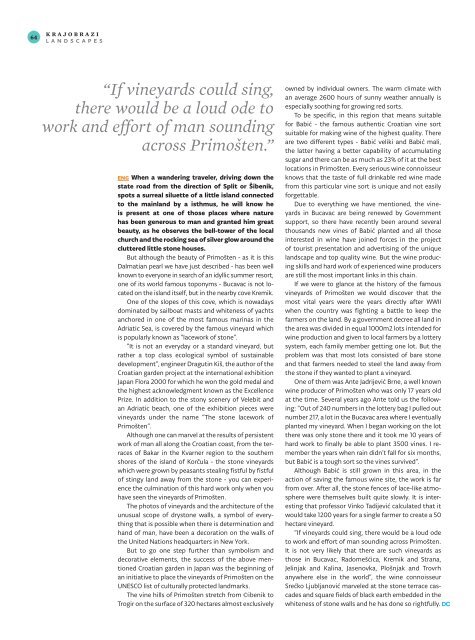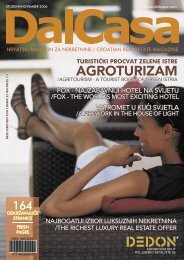Golf Park Dubrovnik - DalCasa
Golf Park Dubrovnik - DalCasa
Golf Park Dubrovnik - DalCasa
- No tags were found...
Create successful ePaper yourself
Turn your PDF publications into a flip-book with our unique Google optimized e-Paper software.
64k r a j o b r a z il a n d s c a p e s“If vineyards could sing,there would be a loud ode towork and effort of man soundingacross Primošten.”eng When a wandering traveler, driving down thestate road from the direction of Split or Šibenik,spots a surreal siluette of a little island connectedto the mainland by a isthmus, he will know heis present at one of those places where naturehas been generous to man and granted him greatbeauty, as he observes the bell-tower of the localchurch and the rocking sea of silver glow around thecluttered little stone houses.But although the beauty of Primošten - as it is thisDalmatian pearl we have just described - has been wellknown to everyone in search of an idyllic summer resort,one of its world famous toponyms - Bucavac is not locatedon the island itself, but in the nearby cove Kremik.One of the slopes of this cove, which is nowadaysdominated by sailboat masts and whiteness of yachtsanchored in one of the most famous marinas in theAdriatic Sea, is covered by the famous vineyard whichis popularly known as “lacework of stone”.“It is not an everyday or a standard vineyard, butrather a top class ecological symbol of sustainabledevelopment”, engineer Dragutin Kiš, the author of theCroatian garden project at the international exhibitionJapan Flora 2000 for which he won the gold medal andthe highest acknowledgment known as the ExcellencePrize. In addition to the stony scenery of Velebit andan Adriatic beach, one of the exhibition pieces werevineyards under the name “The stone lacework ofPrimošten”.Although one can marvel at the results of persistentwork of man all along the Croatian coast, from the terracesof Bakar in the Kvarner region to the southernshores of the island of Korčula - the stone vineyardswhich were grown by peasants stealing fistful by fistfulof stingy land away from the stone - you can experiencethe culmination of this hard work only when youhave seen the vineyards of Primošten.The photos of vineyards and the architecture of theunusual scope of drystone walls, a symbol of everythingthat is possible when there is determination andhand of man, have been a decoration on the walls ofthe United Nations headquarters in New York.But to go one step further than symbolism anddecorative elements, the success of the above mentionedCroatian garden in Japan was the beginning ofan initiative to place the vineyards of Primošten on theUNESCO list of culturally protected landmarks.The vine hills of Primošten stretch from ©ibenik toTrogir on the surface of 320 hectares almost exclusivelyowned by individual owners. The warm climate withan average 2600 hours of sunny weather annually isespecially soothing for growing red sorts.To be specific, in this region that means suitablefor Babić - the famous authentic Croatian vine sortsuitable for making wine of the highest quality. Thereare two different types - Babić veliki and Babić mali,the latter having a better capability of accumulatingsugar and there can be as much as 23% of it at the bestlocations in Primošten. Every serious wine connoisseurknows that the taste of full drinkable red wine madefrom this particular vine sort is unique and not easilyforgettable.Due to everything we have mentioned, the vineyardsin Bucavac are being renewed by Governmentsupport, so there have recently been around severalthousands new vines of Babić planted and all thoseinterested in wine have joined forces in the projectof tourist presentation and advertising of the uniquelandscape and top quality wine. But the wine producingskills and hard work of experienced wine producersare still the most important links in this chain.If we were to glance at the history of the famousvineyards of Primošten we would discover that themost vital years were the years directly after WWIIwhen the country was fighting a battle to keep thefarmers on the land. By a government decree all land inthe area was divided in equal 1000m2 lots intended forwine production and given to local farmers by a lotterysystem, each family member getting one lot. But theproblem was that most lots consisted of bare stoneand that farmers needed to steel the land away fromthe stone if they wanted to plant a vineyard.One of them was Ante Jadrijević Brne, a well knownwine producer of Primošten who was only 17 years oldat the time. Several years ago Ante told us the following:“Out of 240 numbers in the lottery bag I pulled outnumber 217, a lot in the Bucavac area where I eventuallyplanted my vineyard. When I began wor king on the lotthere was only stone there and it took me 10 years ofhard work to finally be able to plant 3500 vines. I rememberthe years when rain didn’t fall for six months,but Babić is a tough sort so the vines survived”.Although Babić is still grown in this area, in theaction of saving the famous wine site, the work is farfrom over. After all, the stone fences of lace-like atmospherewere themselves built quite slowly. It is interestingthat professor Vinko Tadijević calculated that itwould take 1200 years for a single farmer to create a 50hectare vineyard.“If vineyards could sing, there would be a loud odeto work and effort of man sounding across Primošten.It is not very likely that there are such vineyards asthose in Bucavac, Radomešćica, Kremik and Strana,Jelinjak and Kalina, Jasenovka, Plošnjak and Trovrhanywhere else in the world”, the wine connoisseurSrećko Ljubljanović marveled at the stone terrace cascadesand square fields of black earth embedded in thewhiteness of stone walls and he has done so rightfully.
















